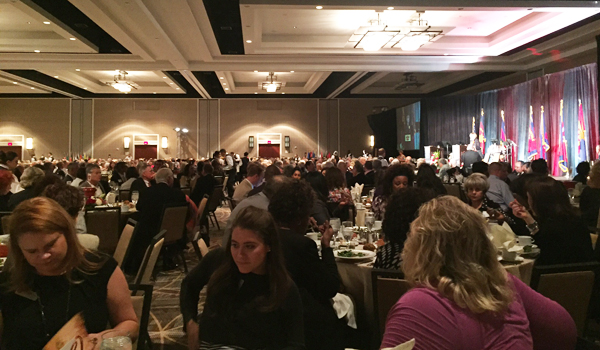A crowd of more than 900 packed the Arizona Biltmore’s Frank Lloyd Wright Ballroom to celebrate the Salvation Army‘s 150th anniversary.
William Booth’s mission was to help feed the hungry and homeless and lift up the thieves, prostitutes and drunkards who needed salvation in the abject poverty of London in 1865. As he helped people one at a time, he probably never could have imagined that his mission — which he named the Salvation Army — would be serving in 124 countries around the world and meeting the physical and spiritual needs of those in need 150 years after his vision became a realization.
This year marks the Salvation Army’s 150th anniversary internationally and it has been a social service provider in the Southwest since 1893. The Salvation Army has a presence in 127 countries and nearly 8,000 centers of operation are in place across the United States.
“We are hoping that (today’s) event will also be a launch for our strategic outreach of continuing to meet the growing needs of those who come under our influence each day,” said Lt. Col. Joe Posillico, the southwest divisional commander for the Salvation Army.
Impact in Arizona
The Salvation Army’s presence in Arizona dates back to before statehood, when Captain William McIntyre founded the Army in Phoenix. The Army’s first unit of operation in the state was at one of Phoenix’s most notorious saloons, “The Road to Ruin,” Posillico said. Once the saloon was taken over by the Army, it was renamed “The Road to Heaven” and Mclntyre led open-air religious meetings to attract converts to the faith, while also helping the needy, said Marlene Klotz-Collins, a volunteer and member of the Salvation Army Phoenix Advisory Board for 32 years.
The Army quickly spread to Prescott and Tucson. Since then, the Army has had a significant impact in the state, from serving those in the 1930s who ran out of money while traveling through Arizona en route for California, to opening different community centers.
Today, the Salvation Army operates across the state with different communities centers and social service outreach. There are 25 corps serving communities with countless social services, ranging from helping the homeless to substance abuse recovery to helping disadvantaged youth. Additionally, there are 35 service extension units serving the rural areas of Arizona that are too small to support a full corps, Posillico said.
The Army also has two adult rehabilitation centers, one in Phoenix and one in Tucson. Each center offers a free six-month substance abuse recovery program. The Army also operates low-income senior housing, a homeless shelter and a domestic violence shelter.
Meeting the needs
Collectively, these operations and a host of other programs address emergency assistance needs, disaster services, help for seniors, aid to the military, holiday dinners, academic and sports programs for youth and daily meals provided to shut-ins.
“I believe the Salvation Army has a profound impact on Arizona, particularly when focusing on the enormous range of programs and services provided throughout our state,” Klotz-Collins said.
The Salvation Army touches a lot of communities in Arizona, whether it be through one of its community centers, low-income housing residences, social service outreach, substance abuse programs or one of the local community based service extensions.
“With the exception of the government, the Salvation Army may well be the largest provider of social services in Arizona, touching countless areas of need,” Klotz-Collins said. “The Salvation Army not only provides a pathway of hope to those who need it most, it is also one of the best kept secrets.”
Arizona accomplishments
Among the Salvation Army’s significant accomplishments in Arizona is the construction and opening of the Ray and Joan Kroc Community Center at South Mountain. Since the opening of the Kroc Center, the Salvation Army has been exposed to new sources of trust and development, Posillico said. The state-of-the-art center has increased and enhanced the programs and services that were offered at the original Salvation Army facility, which opened in 1968 and has consistently served the community for more than 40 years.
“There are many individuals, foundations and companies that have shown their trust and support of the Army in the new avenues we have taken,” Posillico said. “We believe we are on the verge of taking all of this to the next level.”
Another significant Arizona achievement is the newly rebuilt Herberger Campus, which houses the Salvation Army’s administrative, social services, and shelter facilities, in addition to the warehouse for its Christmas and food distribution program.
The Salvation Army also has a number of new and upcoming projects:
The Salvation Army has moved the West Valley Sun City Community Center to a new 35,000-square-foot facility off Bell Road and the Avenue of the Arts.
Construction has also started on a new 10,000-square-foot community center in Sierra Vista.
A new 40,000-square-foot Hospitality House and Social Service Center was built in Tucson and opened last summer.
Yuma will be seeing a ground breaking for a new Salvation Army Boys and Girls Club facility in the next few weeks.
Posillico said strategic planning over the next 5-10 years will include programs in Chandler, Estrella Mountain, Flagstaff, South Tucson, Maryvale and the Camp Ponderosa campus in Heber.
Filling a need
Salvation Army officials said the organization’s programs attempt to address the overall needs of individuals, including their physical, social, mental and spiritual needs.
“We are motivated by a spiritual calling from God and a drive to help individuals reach their full potential and to be stable in their lives in those four areas of need,” Posillico said.
In addition to the Salvation Army’s 150th anniversary, this year also marks the 30th anniversary of the Christmas Angel program, which helps more than 50,000 Valley children every Christmas season, Klotz-Collins said.
“I will always consider being part of the team involved in the formation and ongoing growth of the Christmas Angel program as my greatest privilege and accomplishment with the Salvation Army,” Klotz-Collins said.
More than a century and a half later, the Salvation Army still responds to many of the same issues that its founders, William and Catherine Booth, faced in 1865.
“They gave humbly and with heart and soul to serve mankind,” Klotz-Collins said. “That sense of mission and humble spirit will never change.”




